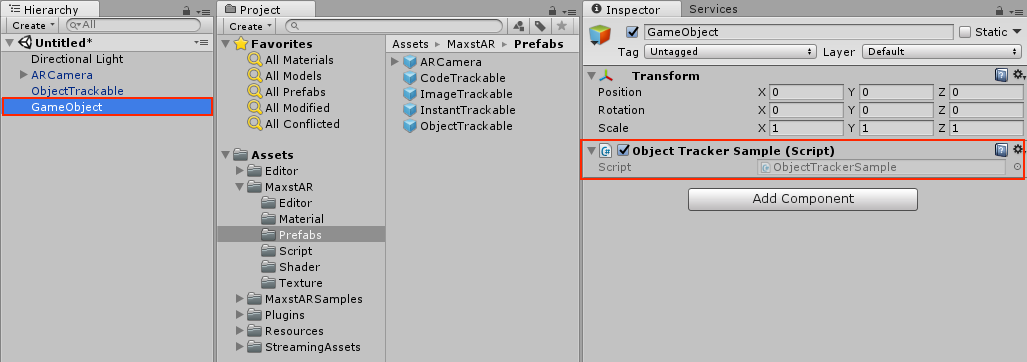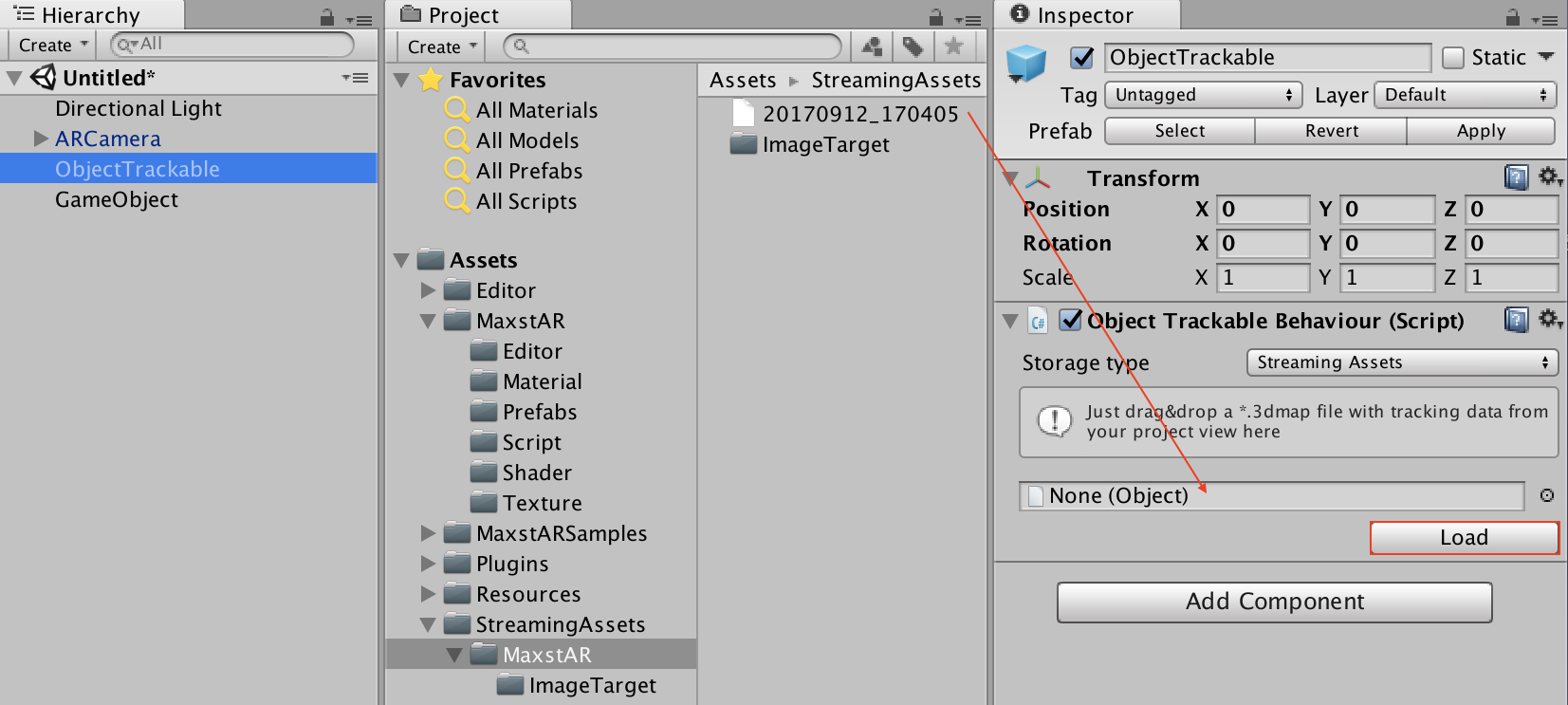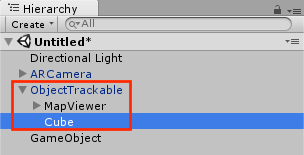Object Tracker
| Related documentations |
|---|
| Map Manager |
| Tracker Coordinate System in Unity |
| Visual SLAM Learning Guide |
The Object Tracker loads the map file and renders a 3D object on it.
Please refer Visual SLAM Learning Guide to create a map more precisely while scanning 3D space.
Make Object Tracker Scene
Set Map
Add / Replace Map
Start / Stop Tracker
Use Tracking Information
Change Tracking Mode
Make Object Tracker Scene
Create the new scene.
Delete the Main Camera that exists by default and add 'Assets > MaxstAR > Prefabs > ARCamera, ObjectTrackable' to the scene.

※ If you build, you should add License Key to ARCamera.
Create an empty object and add 'Assets > MaxstARSamples > Scripts > ObjetTrackerSample' as a component.

Place the map file created by Visual SLAM scene or Map Manager in Assets > StreamingAssets > MaxstAR, and drag map file to Inspector of ObjectTrackable to set map file. Press the Load button to set the map in the map viewer described later.

Create a Cube as a child of ObjectTrakable.

In MapViewer's Inspector, check Generate Mesh, Transparent, and adjust the scale and position of the cube.

※ MapViewer
If you set a map file in ObjectTrackable, MapViewer is automatically created as a child of ObjectTrackable.
Keyframe Id: When creating a map, the camera looks at the target in various directions. At this time, a Keyframe is created for each direction that satisfies a certain condition. If you change Keyframe Id, Mesh / Image of the Keyframe is displayed in Game View. By positioning Cube in each Keyframe, you can position Cube more precisely.
Generate Mesh: If checked, the image displayed in the Game View changes to Mesh.
Auto Camera: If checked, the Keyframe closest to the screen of Scene View is automatically selected.
Transparent: If checked, Mesh / Image becomes transparent.
The cube will be augmented by illuminating the space learned in the camera after playing.
Set Map
By calling addTrackerData () to register the map file and calling loadTrackerData (), Space can be tracked. To set a map, refer to the following code.
>ObjectTrackerSample.cs
private void AddTrackerData()
{
foreach (var trackable in objectTrackablesMap)
{
if (trackable.Value.TrackerDataFileName.Length == 0)
{
continue;
}
if (trackable.Value.StorageType == StorageType.AbsolutePath)
{
TrackerManager.GetInstance().AddTrackerData(trackable.Value.TrackerDataFileName);
}
else
{
if (Application.platform == RuntimePlatform.Android)
{
TrackerManager.GetInstance().AddTrackerData(trackable.Value.TrackerDataFileName, true);
}
else
{
TrackerManager.GetInstance().AddTrackerData(Application.streamingAssetsPath + "/" + trackable.Value.TrackerDataFileName);
}
}
}
TrackerManager.GetInstance().LoadTrackerData();
}
Add / Replace Map
Create a map file refer to Map Manager
Copy the received map file to the desired path.
If you have an existing map file, call AddTrackerData () and LoadTrackerData () after calling TrackerManager.GetInstance ().RemoveTrackerData().
Start / Stop Tracker
To start / stop Tracker after loading the map, refer to the following code.
>ObjectTrackerSample.cs
void Update()
{
...
if (!startTrackerDone)
{
TrackerManager.GetInstance().StartTracker(TrackerManager.TRACKER_TYPE_OBJECT);
...
}
...
}
void OnApplicationPause(bool pause)
{
...
TrackerManager.GetInstance().StopTracker();
...
}
void OnDestroy()
{
TrackerManager.GetInstance().StopTracker();
TrackerManager.GetInstance().DestroyTracker();
...
}
Use Tracking Information
To use the Tracking information, refer to the following code.
>ObjectTrackerSample.cs
void Update()
{
...
TrackingState state = TrackerManager.GetInstance().UpdateTrackingState();
TrackingResult trackingResult = state.GetTrackingResult();
for (int i = 0; i < trackingResult.GetCount(); i++)
{
Trackable trackable = trackingResult.GetTrackable(i);
if (!objectTrackablesMap.ContainsKey(trackable.GetName()))
{
return;
}
objectTrackablesMap[trackable.GetName()].OnTrackSuccess(trackable.GetId(), trackable.GetName(), trackable.GetPose());
}
}
Change Tracking Mode
2 Tracking Modes of Object Tracker:
JITTER_REDUCTION_ACTIVATION, JITTER_REDUCTION_DEACTIVATION
- JITTER_REDUCTION_ACTIVATION: Jitter reduction.
TrackerManager.GetInstance().SetTrackingOption(TrackerManager.TrackingOption.JITTER_REDUCTION_ACTIVATION);
- JITTER_REDUCTION_DEACTIVATION: Disable the jitter reduction option.
TrackerManager.GetInstance().SetTrackingOption(TrackerManager.TrackingOption.JITTER_REDUCTION_DEACTIVATION);



